Fujifilm X-T20 Review
Fujifilm X-T20 Introduction
The Fujifilm X-T20 was released in early 2017 as a follow up to the highly-acclaimed X-T10 with an upgraded imaging pipeline. It sports the next generation 24 megapixels X-Trans CMOS III sensor and X Processor Pro, replacing the 16 megapixels X-Trans CMOS II and EXR II processor of the X-T10. One generation difference provides it with 50% more megapixels while keeping the same full ISO 100-51200 sensitivity range and increasing Phase-Detect points from 77 to 325.
The new X Processor Pro and hybrid shutter allows the X-T20 to continuous capture full-resolution images at 14 FPS. An upgraded buffer allows for 42 JPEG images or 23 RAW files per burst. This is a significant improvement over the X-T10's 8 FPS drive that only managed 8 frames, regardless of format. The shutter-speed range remains the same though at 1/32000-30s, plus Bulb exposures of up to an hour.
The highly-mechanical design of the X-T20 blends analog and digital controls in an elegant and sturdy metal body. It offers direct dials for EC, Shutter-Speed and Drive-Mode, plus dual control-dials which give efficient access to all essential photography controls.
The new X-T20 is externally identical to its predecessor. It offers the same 0.39" EVF with 2.4 megapixels, 100% coverage, 0.62X maginification and an extremely useful Eye-Start sensor. As the mid-range offering among Fujifilm mirrorless, the X-T20 is not weatherproof or freezeproof.
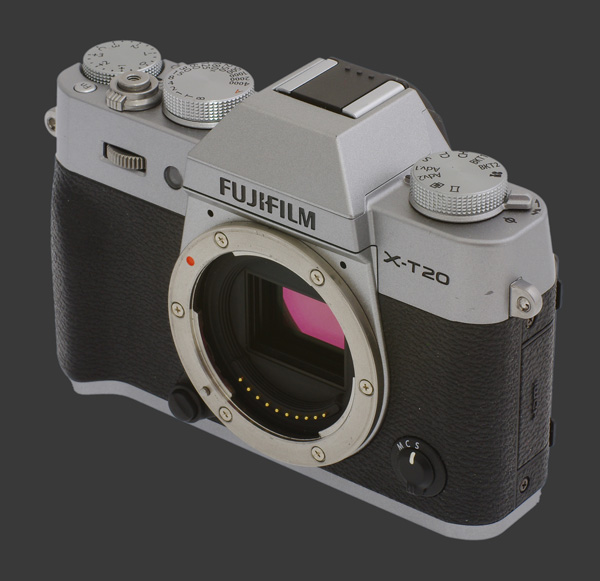
The X-T20 uses Fuji's own XF lens mount which has a very short flange distance. This makes it easier to design high-quality lenses and lens-mount adaptors, including one made by Fuji for the Leica M-mount. Fuji launched a total of 20 lenses by now. Plus, there are third-party lenses from Zeiss and Samyang now, plenty of options, besides long telephoto lenses.
This digital camera review analyses the performance and image quality of the Fuji X-T20.
Fuji X-T20 Features
Sensor
- 24 Megapixels CMOS sensor
- X-Trans 6x6 Color-Filter Array
- No Anti-Alias filter
- 1.5X Crop factor (APS-C)
- 3:2 Aspect ratio
- Phase-Detect AF
- Fuji XF lens mount
- Dust-Reduction
Exposure
- ISO 200 to 12800 sensitivity range, 1/3 EV steps
- ISO 100, 25600 & 51200 expansion
- Auto ISO, Selectable maximum from 400 to 12800
- ISO Bracketing, 3 frames, 1/3-1 EV steps
- Hybrid Shutter, 1/3 EV steps:
- Mechnical: 1/4000s-30s Shutter-Speeds
- Electronic: 1/32000-30s, ISO 200-12800 Only
- EFCS: 1/32000-30s, ISO 200-12800 Only
- 1/32000-30s Shutter-speeds, 1/3 EV steps
- Bulb exposure, maximum 1 hour
- PASM Exposure modes
- Multi-Segment, Center-Weighed, Spot and Average metering
- Exposure-Compensation, ±5, 1/3 EV steps
- AEB, 3 frames, 1/3-2 EV increments
- 100%, 200% or 400% Dynamic-Range
- Flash-Compensation, ±2, 1/3 EV steps
- On, Slow, Manual, Wireless or Off Flash Modes
- Rear or Front Curtain Sync
- Optional Redeye Removal
Image Parameters
- Automatic, 7 presetsSunny, Shade, 3 Fluorescents, Incandescent, Underwater, Kelvin and Custom WB
- WB fine-tuning along 2 axis in 19 steps
- WB Bracking, 3 frames, 3 step sizes
- Film Simulation: Provia, Velvia, Astia, Classic Chrome, Pro Negative Hi, Pro Negative Across Monochrome plus 3 filters, Standard B&W plus 3 optional filters, Sepia
- Film Simulation Bracketing, 3 frames
- Adjustable Highlight & Shadow Tone, 7 steps each
- Adjustable Color, Sharpness and Noise reduction, 9 steps each
- Optional Long Exposure Noise Reduction
- Optional Lens Modulation Optimizer
- Optional Grain Effect
Focus
- Hybrid 325-Point AF system
- Single-Shot AF, Continuous AF, DMF or MF
- Point AF Selection, 325-Points, 5 sizes
- Zone AF Selection, 91 areas, 3 sizes
- Wide Tracking AF-C, 5 settings
- Optional Prefocus
- Optional Face/Eye Detection
- Optional Electronic Magnification
- Optional Digital Split Image
- Optional Focus Peaking
- Optional AF-Assist lamp
- Optional Touch AF
- Fly-By-Wire focus-ring on most lenses
Drive
- 14 FPS Continuous Drive
- 42 JPEG or 23 RAW Buffer
- Motion Panorama, Normal or Wide, 4 Directions
- Interval Timer, 1s-24h interval, 1-999 or Infinite frames, 0m-24h delay
- Multiple-Exposure, 2 frames
- Self-timer, 2s or 10s
Video
- 3840x2160 @ 30 FPS 4K Ultra-HD
- 1920x1080 @ 60 FPS 1080p Full-HD
- 1280x720 @ 60 FPS 720p HD
- Area or Auto AF Selection
- MPEG-4 Codec or HDMI Output
- Built-in Stereo Microphone
- Mini-Jack Stereo Audio Input, 4 levels
Display & Viewfinder
- 0.39" EVF, 2.4 Megapixels, 0.62X Magnification
- 100% Coverage
- Eye-Start sensor
- 3" Tilting LCD, 1 Megapixel
- Tempered Glass Touchscreen
- Digital Level, 1-axis
- Depth-Of-Field Preview
- Depth-Of-Field Scale
- Optional Live-Histogram
- Optional Framing-Guides, 3 types
Output Processing
- 3:2 Native aspect ratio
- 16:9 and 1:1 cropped aspect ratios
- 24, 12 and 6 megapixels modes
- JPEG, RAW, RAW+JPEG capture
- 2 JPEG Compression levels
- Optional Lossless RAW Compression
Misc
- Dual control-dials
- Exposure-Compensation dial
- Customizable Rear Control-Dial
- Shutter-speed dial, full-stops only
- Aperture ring on lenses
- 7 Customizable Buttons
- AF-On, AF-S or AF-C mode
- Standard Hot-Shoe
- Wired-Remote connector
- 4K HDMI output
- USB 2.0 connectivity
- Lithium-Ion battery
- SDXC Slot, UHS-II Support
- Built-in WiFi
Given that the Fujifilm X-T20 has a body identical to its predecessor, read the first page of the X-T10 review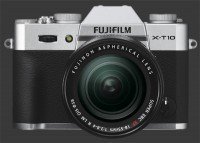
Fujifilm X-T10 for an in-depth analys of Usability.
Fujifilm X-T20 Capability - What can it do?
The X-T20 is a compact advanced mirrorless digital camera. It is the smaller sibling to the X-T2 which offers a very similar feature-set in a larger weatherproof body. It has plenty of controls with direct dials to control Drive, Shutter-Speed, Exposure-Compensation and dual control-dials, plus supports the Aperture-Ring which is found on most X-mount Fujinon lenses.
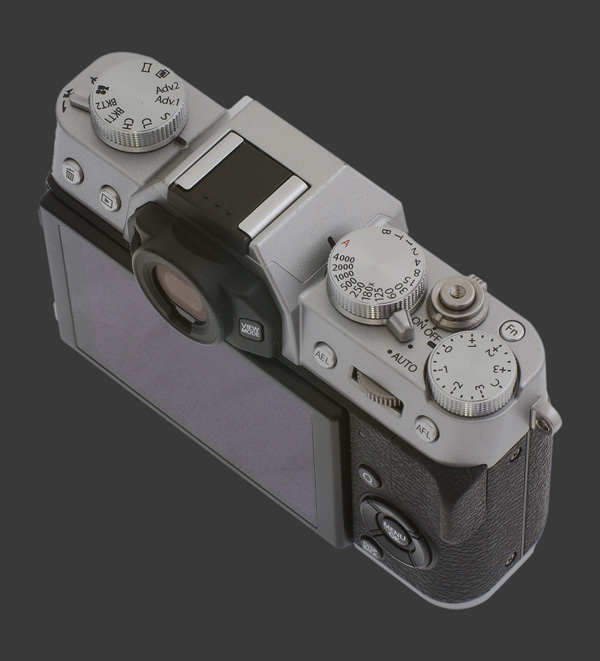
As one would expect, the X-T20 has a full complement of manual controls, including Auto, Preset and Custom White-Balance options, all fine-tunable in 19 steps along 2 axis. A virtual bracketing option that saves 3 images with different WB adjustments is available too with 3 step sizes to choose from along the Y-B axis. There are four choice of metering patterns, one more than usual: Multi-Segment, Center-Weight, Average and Spot. There are 3 Auto ISO settings, all customizable with a starting and maximum ISO, plus a minimum shutter-speed. Otherwise, ISO can be manually set from 200-12800 in 1/3 steps. Expanded ISO 100, 25600 and 51200 sensitivities are also available when using the mechanical shutter only.
Fujifilm has its own rendering engine based around Film Simulation mode with a number of parameters to adjust JPEG output as desired. Color, Sharpness and Noise-Reduction are each adjustable in 9 fine steps while Shadow-Tone and Highlight-Tone have 7 very coarse steps. None of these affect RAW output. For the unsure, there is a virtual bracketing mode for Film Simulation which takes one shot and saves it using 3 different Film Simulation modes chosen by the user.
The X-T20 offers two types of exposure bracketing. One is the usual AEB which varies shutter-speed and aperture, the other is one that varies ISO. For standard AEB, steps of 1/3 to 2 EV are available, while ISO Bracketing allows 1/3 to 1 EV steps. In either case, 3 distinct frames are captured. There is standard 2s or 10s Self-Timers, plus an Interval Timer which can capture as many frames as will fit on a memory card. Users can select any interval from 1s to a full day and a starting delay of up to 24 hours in one minute increments. Multiple-Exposure can combine two frames. Notably absent from this and other Fujifilm mirrorless cameras is built-in HDR capture.
Drive modes are highly customizable with continuous speeds available from 3 to 14 FPS. At maximum speed, the buffer can hold 42 JPEG images or 23 RAW files before slowing down while it writes to a SDXC UHS-1 card in the single-slot of the X-T20. This mirrorless makes use of its continuous drive and hybrid shutter to offer a Motion Panorama mode. This one creates a panoramic image of 180° or 120° while the camera is physically panned in any of the 4 cardinal directions.
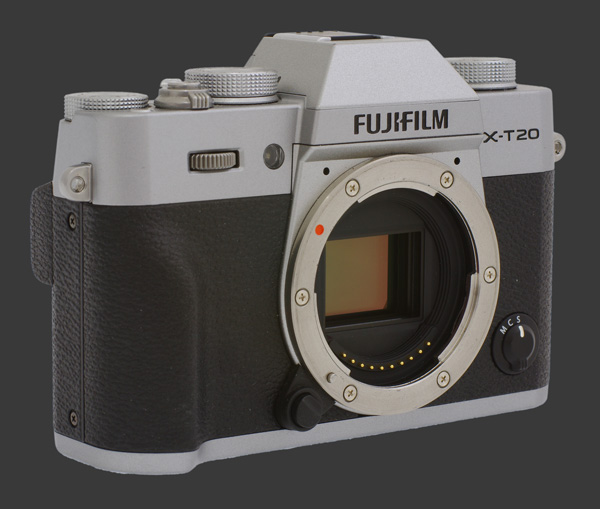
It is possible to record 4K Ultra-HD video at 30 FPS with the Fujifilm X-T20. It can also record 1080p video at 60 FPS and the X-T20 is one of the few cameras to still have a 720p option, for when memory-space is low. Options for 24, 25, 30, 50 and 60 FPS are available for HD resolutions, while Ultra-HD is possible at 24, 25 or 30 FPS. Manual controls apply to video as well, although expanded ISO and Custom Auto ISO settings are not available. This mirrorless supports stereo audio input from an external microphone. An interesting option is to have 4K Ultra-HD video output over HDMI rather than stored in memory.
With all these features and plenty of external controls, the Fujifilm X-T20 is capable of any type of photography when paired with the right lens. Low-light capabilities depend on optical image stabilization built into some Fujinon lenses. There are currently over 40 lenses made for the X-mount, most of them by Fujifilm themselves. Rectilinear lenses cover focal-lengths from 10 to 400mm. There are no bright telephoto lenses though and so wildlife and some types of sports photography are out-of-reach from all Fujifilm mirrorless cameras.
Speed is a major performance aspect of the X-T20 and it is sufficiently fast to capture action thanks to a state-of-the-art 325-Point Hybrid Phase-Detect and Contrast-Detect AF system plus a 14 FPS continuous drive. With a maximum shutter-speed of 1/32000s available up to ISO 12800, this mirrorless can freeze almost any action. Crucially, the large and bright EVF built into the X-T20 keeps up very well with action with virtually no blackout.
The Fujifilm X-T20 is fairly well suited to low-light photography for a mirrorless. It offers metered exposures of 30s and Bulb exposures of up to an hour. The EVF and LCD even stay visible in relatively low-light yet have a hard time at light levels needed for astrophotography. A bright lens really helps here since the EVF and AF is done with the lens wide-open.
While it is suitable for any type of photography, there are several features lacking in this mirrorless which make it less efficient than other advanced models. One of the most popular techniques of the digital photography age is HDR. The X-T20 is missing a feature to do it in-camera and is lacking sufficiently large bracketing increments to quickly capture a set for merging later on a computer.
Fujifilm X-T20 Performance - How well does it take pictures?
Performance starts with image quality, which is the criteria used as the foundation of our digital camera ratings. Ergonomic issues may get in the way, but in the end, image quality counts the most. For an ILC, image quality greatly depends on the lens used. While color, noise, exposure and dynamic-range are properties of a camera, distortion, vignetting and chromatic aberrations are properties of the lens. Sharpness and contrast depend on the weakest link. That is, a camera cannot capture more details than a lens lets through. Conversely, it is quite possible for a lens to transmit more details than a sensor can capture.
Image Noise & Details
The Fujifilm X-T20 delivers image quality comparable to the best APS-C cameras available today. The X-T10 before it already delivered class-leading image quality and the X-T20 manages even exceed it slightly while increasing resolution by a significant 50%. Per-pixel-sharpness is just not quite as sharp but every close. The higher-resolution of the X-T20 really is more sensitive to lens performance and hits the diffraction limit earlier.
ISO 100 to 800 are perfectly smooth usable for rather large prints that can stand critical inspection. Image noise is nearly invisible until ISO 1600 where it starts appearing when viewed at 100%. From ISO 100 to 800 though, maximum-sized prints look absolutely perfect.
ISO 3200 show a mild increase in noise which comes with a noticeable loss of details due to noise-reduction. At these sensitivities, print sizes get reduced yet mid-sized prints such as 15"x10" still come out looking good. Color and contrast are surprisingly well-maintained at this sensitivity.
As it happens sometimes with overly aggressive noise-reduction, ISO 6400 looks a little better than 3200. Images at that sensitivity are visibly more noisy yet that hides the blurring of details from noise-reduction. This sensitivity can produce some fairly decent mid-size prints up to 12" x 8". ISO 12800 gets more noise and a little softer too, so prints are limited to relatively small sizes.
The expanded ISO 25600 setting remains usable for small prints. This is very good performance. Colors and contrast are still well-maintained even that such a high ISO. The finest details are gone by then but once shrunk to a small size will appear very reasonable. The final expanded ISO of 51200 is barely usable. This is about a full-stop of improvement over previous generation which allows Fujifilm to keep up with the competition.
Sharpness is controllable in 9 levels. Things start from a very soft to over-sharp, so each step is quite coarse. The default level leaves a little softness and one above adds a touch of sharpness with minimal artifacts. Recall that the X-Trans CMOS III sensor has no Anti-Alias Filter is not prone to moire either, so it is capable of capturing very fine details.
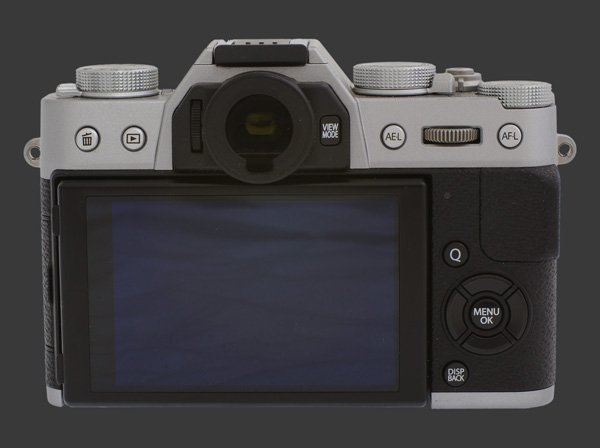
Color & White Balance
Color accuracy of the X-T20 is very good. Hues are realistic with Film Simulation modes mostly affecting saturation. The Provia film simulation gives a very natural rendition of colors. Fujifilm is renowned for their expertise in color. The X-T20 offers a high number of Film Simulation modes to cater to different tastes. Each one is further adjustable with 9 levels of saturation, where the default is set right in the middle which works out to realistic colors for Provia.
Automatic White-Balance is quite dependable under typical conditions. It handles both natural and artificial lighting surprisingly well, only leave the occasional yellow cast under incandescent lighting. The twisted issue though is that AWB is sometimes previewed incorrectly, tricking the user into incorrectly changing settings. The Custom White-Balance option is there for difficult situations and is perfectly accurate.
Exposure & Dynamic-Range
The Multi-Segment metering system of the X-T20 is generally quite reliable. It is slightly less conservative than its predecessors yet it manages to avoid burning major highlights. Exposure is usually spot-on and it is rarely off by more than 2/3 EV. Unfortunately, blown highlights on the LCD and EVF are rather common but seldom occur in pictures taken since these have a much more limited dynamic-range than the sensor.
In addition to the Multi-Segment metering mode, this camera offers Center-Weighed, Spot and Average modes. Center-Weighed is a less sophisticated version of Multi-Segment and much more prone to overexposing the background. Spot and Average metering work just as expected.
All Fujifilm mirrorless camera have controllable Dynamic-Range. At its native sensitivity of ISO 200, the camera is set to capture a normal dynamic range which is referred to as 100% DR. While this setting does not change at Low ISO 100, there is clearly a loss of dynamic-range at that sensitivity. Starting at ISO 400, the X-T20 allows 200% DR to capture twice the dynamic-range. This gives it a dynamic-range comparable to top-of-the-line APS-C digital cameras. From ISO 800 to 12800, it is possible to select 400% DR which captures 2 stops more dynamic-range than the standard level. At that level dynamic-range is truly exceptional for an APS-C sensor.
The X-T20 can capture high-contrast scenes better than most mirrorless cameras thanks to its dynamic-range control. One can simply select 400% DR and the camera will reduce it to 200% or 100% when the chosen dynamic-range is unavailable.
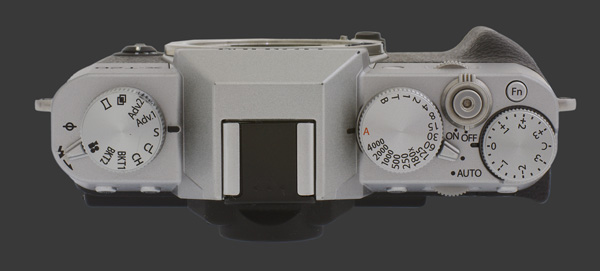
Auto Focus
Fujifilm pioneered on-sensor Phase-Detection and introduced it in its mirrorless cameras with the X-E2 and has been working on it ever since. The new Fujifilm X-T20 takes it up a notch with a 325-Point AF system that combines Phase-Detection and Contrast-Detection plus subject recognition to track focus across most of the frame. A 91-Point grid of Phase-Detect sensors covers 75% of the vertical image area and 50% of the horizontal one. Contrast-Detect points complete the set.
Autofocus on the X-T20 is very quick and extremely precise. There are virtually no focus misses in Focus Priority mode, which is the default when the camera is set to Single-Shot. Keep in mind that the default when Continuous Drive is engaged is Release Priority. That can lead to focus misses since the AF system is not quite capable of tracking as fast as the camera can shoot. An option in the AF/MF menu allows this to be changed at the expense of uneven shooting speed.
The hybrid AF system of this camera is sensitive down to moderately low light levels. In good light, it looks very decisively yet it shows hesitation in typical indoor lighting. The autofocus algorithm takes depth-of-field into account, so it noticeably slows down at close range where depth-of-focus is more shallow.
Continuous AF can track subjects moving at moderate speeds yet it cannot follow objects that occupy a very small part of the frame. There are continuous focus modes to track different types of motion: Standard, Obstacle, Acceleration, Frame Entry and Erratic Movement. The top drive speed of the X-T20 is 14 FPS is only available for Single-Shot AF. When using Continuous AF, speeds drop to a respectable 8 FPS although it keeps up with action better at 5 FPS.
The focusing system in the X-T20 is extremely flexible. Giving it a wider area increases the chances of quickly locking focus while risking to do so on the wrong subject. This makes it critical to select the right target size which there are 10 of, from a single point to nearly the entire frame.

Speed
The Fuji X-T20 is a fast digital camera. It can shoot continuously at up to 14 FPS for up to 42 JPEG images or 23 RAW files. This is possible only with the Electronic Shutter which is completely silent. There is also a similar 11 FPS mode. When using the Mechanical Shutter, it can shoot at 8 FPS for up to 62 JPEGs or 25 RAWs. There are 5, 4 and 3 FPS modes which allow longer bursts. The internal buffer clears quickly when using a UHS-I memory card.
This mirrorless is quite responsive. Nearly all actions occur without delay. When enabled, the Instant Review is absolutely instantaneous. Too bad images cannot be deleted right there.
The following measurements characterize the performance of the Fuji X-T20:
- Power-On: ½s. Very good.
- Power-On to First-Shot: 2s. Below average.
- Autofocus: ¼s-½ typically, up to ¾s when close-focus in low-light. Quite good.
- Shutter-lag: Instant with nearly no blackout. Excellent.
- Shot-to-shot: 2/3s with AF, ½s in MF. Average.
- Playback: ¾s to enter or exist. Below average.
- Power-Off: 1s, including sensor cleaning. Good.
- Video: Instant start but 1s delay to stop. Average.
The Fujifilm X-T20 clearly turns in a mixed performance. While it actually powers on very quickly, it is not actually ready until over a second later. If the shutter-release is pressed before that, it simply does not shoot. The good news though is that the new 325-Point Hybrid Phase-Detect and Contrast-Detect AF system is quite fast. Focus is locked very quickly in good to moderate lighting, slowing down as light gets low. This obviously depends on the lens used and particularly its maximum aperture since AF is always measured wide-open.
While the all-important shutter-lag is superb and even the instant review appears immediately, shot-to-shot speeds are not great. The camera seems to need time to recover between shots when not in continuous mode. There is also a very noticeable delay while the camera switches between Capture and Playback modes. Having a dedicated video mode lets the X-T20 be ready to film and start recording immediately. For an odd reason though, it stops a full second too late but this is immensely better than starting behind as cameras without a video mode often do.
The Fuji X-T20 is powered by a small proprietary Lithium-Ion battery which provides 350 shots-per-charge which is average for a mirrorless. The battery gets drained fairly rapidly and several would be needed for a full day of shooting. One thing that significantly improves battery-life is a mode that switches the EVF on or off based on the Eye-Start Sensor, while maintaining the rear LCD off.
Fujifilm X-T20 Conclusion
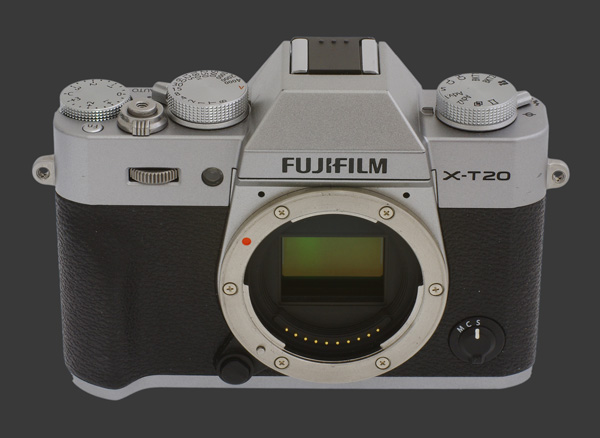
The Fujifilm X-T20 is a worthy successor to the X-T10 which previously set the benchmark for mirrorless cameras. Its fusion of analog and digital controls continues to provide a highly efficient interface while its excellent 2.4 megapixels EVF with 100% coverage, 0.62X magnification and an Eye-Start Sensor delivers a very nice viewfinder experience.
The body carried over from its predecessor is sturdy and very compact for an APS-C camera with dual control-dials and still manages to offer direct dials for EC, Shutter-Speed and Drive Mode. While some controls have their share of quirks, in particular the overly retro shutter-speed dial, most issues are minor. Bracketing is odd though and forcefully only saves the sequence out-of-order.
A latest-generation 24 megapixels X-Trans CMOS III sensor with built-in Phase-Detection AF paired with an X-Processor Pro to produce superb high-resolution images. Image noise is very low while details are kept sharp. Dynamic-range and metering are very reliable, while colors come out very pleasing. White Balance too performs remarkably well. Photographers must be careful though since the EVF on the X-T20 is not Exposure-Priority and shows an incorrect preview which often appears over-exposed and is too dark at other times.
Performance of the X-T20 is generally good. The camera becomes completely responsive as soon as it finishes its power-on cycle which is just a little slower than average. The 325-Point Hybrid Phase-Detect and Contrast-Detect AF system is fast and very accurate in single-shot mode. Continuous AF is reasonable for candid photography but cannot keep up with fast action, despite a rather high 14 FPS maximum drive speed. Shutter-lag though is instantaneous with virtually no black out, so it is easy to catch a moment. Video capture also starts immediately with the correct framing previewed since the X-T20 has a dedicated video mode.
The Fuji X-T20 produces superior image-quality while being efficient to operate. At the same time, one must be keep an eye on camera settings more closely than usual. The EVF is very nice, providing a very sharp and large view, although not a very accurate one. Although it lacks the weather-sealed and freezeproof body of the top-of-the-line X-T2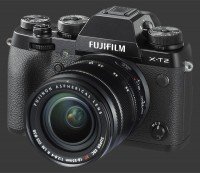
Fujifilm X-T2, the X-T20 is smaller and easier to use. Overall, the Fujifilm X-T20 delivers a well-rounded performance combining high image-quality and compactness.
 |
Please Support Neocamera
All information on Neocamera is provided free of charge yet running this website is a huge endeavor. Purchases made via affiliate links found throughout the site help keep it running and up-to-date. There is no additional cost to you, so please consider buying via these links to our affilates:
If you found any information on this site valuable and did not purchase via our affiliate links, please considering donating via PayPal:
Any amount will be greatly appreaciated. Thank you for your support!
Fujifilm X-T20 Highlights
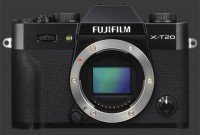
Sensor-Size: 24 x 16mm

Actual size when viewed at 100 DPI
| 24 Megapixels Mirrorless | ISO 100-51200 |
| Fujifilm X Mount 1.5X FLM | Shutter 1/32000-30s |
| 0.39" Built-in EVF 2.4 Megapixels (0.62X) | Full manual controls, including Manual Focus |
| Automatic Eye-Start sensor | Custom white-balance with 2 axis fine-tuning |
| 1 Axis Digital Level | Spot-Metering |
| Built-in Dust Reduction | Hot-Shoe |
| 14 FPS Drive, 42 Images | Stereo audio input |
| 3840x2160 @ 30 FPS Video Recording | Lithium-Ion Battery |
| 3" LCD 920K Pixels | Secure Digital Extended Capacity |
Updates
2025.01.18

Fujifilm GFX 2025 Lens Roundup
Lens Review roundup of Fujifilm GFX Medium-Format lenses. Quality, performance and handling of the GF20-35mm F/4R WR, GF30mm F/3.5 Tilt-Shift and the GF55mm F/1.7.
2024.11.18

Best 2024 Photography Gifts for Every Budget
Great gifts for photographers and photo enthusiasts selected for every budget among the best products of 2024.
2024.08.07

Eye Protection Tips for Professional Photographers
The four main considerations for professional photographers regarding eyewear.
2024.07.14

Fujifilm X100VI Review
Flagship fixed-lens compact digital camera with a 40 MP sensor and Image-Stabilization, a first for the series. Retro design featuring dual control-dials, plus direct ISO, Shutter-Speed and EC dials. Its hybrid viewfinder can switch between EVF and OVF mode.
2024.05.09

Fujifilm GFX100 II Review
Flagship 102 Megapixels Medium-Format Mirrorless Digital Camera with 8-Stop 5-Axis IBIS, 8 FPS Drive, 8K Video and 400 MP Super-Resolution capture in a weatherproof and freezeproof body with dual control-dials and dual memory-card slots.
2024.04.03

Fujifilm X-T5 Review
Newest Fujifilm flagship boasting a 40 MP APS-C sensor, 5-axis IBIS with 7-stop efficiency, 15 FPS continuous drive, 6.2K Video capture, dual control-dials and dual SDXC UHS-II slots in a sturdy weatherproof and freezeproof body.
2023.11.20

Best Digital Cameras of 2023
Find out which are the Best Digital Cameras of 2023. All the new Mirrorless Digital Cameras from entry-level to high-end professional.
2023.07.10

Fujifilm X-H2 Review
40 Megapixels APS-C Hybrid Mirrorless Digital Camera with 7-stop IBIS. Fastest shutter ever and 8K video capture. Large builtin EVF with 0.8X magnification and 5.8 MP, plus an Eye-Start Sensor. Packed with features and large number of controls in a weatherproof and freezeproof body.
2023.05.07

Sony FE 20-70mm F/4G Review
Review of the unique Sony FE 20-70mm F/4G lens. The optical zoom of this lens spans ultra-wide-angle and medium focal-length coverage, making it one of the most versatile Full-Frame lenses on the market.
2023.01.15

Huion Inspiroy Dial 2 Review
Review of the Huion Inspiroy Dial 2 tablet, a medium sized drawing surface with dual dials and customizable buttons. Connects via USB-C or Bluetooth 5.0 with Windows, Linux and Android support.
2022.12.08

How to Pack for a Photo Trip
Find out how to pack for a travel photography trip, carry your gear safely while meeting airline regulations.
2022.11.13

Best Digital Cameras of 2022
The best digital cameras of 2022. A short list of the most outstanding models in their respective categories. Choose one for yourself or as a gift.













